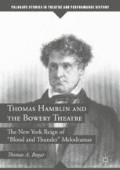Abstract
Elizabeth Hamblin returns from England and discovers her husband’s infidelity. Intensely jealous of Vincent and Clifton, now touring as stars, she files for divorce. Hamblin falls ill with cholera, and Elizabeth nurses him back to health. As actor and as manager, Hamblin strikes a balance between melodrama and the tragedies of Shakespeare, especially those with sufficient swordplay for his Bowery boys and those starring Booth, whose unpredictable behavior infuriates Hamblin. His latest protégée is the beautiful, talented Matilda Flynn, whose husband Tom becomes a Hamblin confidant. Hamblin’s newest Bowery sensation is T. D. Rice, whose “Jump Jim Crow” routine proves wildly popular. Actor disloyalty and turnover continue.
Notes
- 1.
Child 174–75; Fanny Kemble. Journal. Philadelphia: Carey, Lea & Blanchard, 1835, I:86.
- 2.
Wemyss, Theatrical Biography, 172.
- 3.
John Doran, ed., “Their Majesties’ Servants.” III:269.
- 4.
Clarke 21. Clarke may well have befriended Vincent more for acquiring anti-Hamblin gossip than out of genuine concern for the girl’s welfare.
- 5.
Wemyss, Twenty-Six Years 202; Wood 364; Philadelphia Chronicle, Feb. 20 and Mar. 9, 1832.
- 6.
Durang PSD, Jan. 18, 1857.
- 7.
Drew 51; Clarke 24–26.
- 8.
Philadelphia Chronicle, Mar. 1, 1832.
- 9.
Clarke 24; James Marshall Leonard. “The Letters of William Duffy.” Ph.D., Cornell University, 1971, 90.
- 10.
Philadelphia Chronicle, Mar. 9, 1832.
- 11.
MCNYE quoted in Philadelphia Album and Ladies’ Literary Portfolio, Apr. 21, 1832; NYA, Apr. 12, 1832; NYEP, Apr. 21, 1832 and MCNYE, May 9, 1832.
- 12.
Philadelphia Album and Ladies’ Literary Portfolio, Apr. 21, 1832; Clarke 24.
- 13.
Clarke 25.
- 14.
Ibid.
- 15.
SotT, May 5 and 12, 1832; MCNYE, May 5, 1832.
- 16.
Records of New York Association, vol. 2: April 26 and May 1, 1832, HTC, SotT, May 5, 1832.
- 17.
David S. Reynolds. Walt Whitman’s America: A Cultural Biography. New York: Knopf, 1995, 43–44.
- 18.
NYM, June 16, 1832; MCNYE, June 6, 1832.
- 19.
Separation agreement, HTC.
- 20.
Dunlap, Diary III:627.
- 21.
NYM, Sept. 1, 1832.
- 22.
SotT, Sept. 1, 1832.
- 23.
Boston Evening Transcript, Sept. 13 and 21, 1832; Boston Traveler, Sept. 14, 1832; SotT, Sept. 22, 1832.
- 24.
Clarke 30.
- 25.
NYEP, Sept. 25, 1832; NYA, Sept. 24 and 26, 1832; Bowery Playbills, Sept. 24 and Oct. 1, 1832, HTC.
- 26.
NYEP Sept. 27, 1832; ALS Barrymore to Wemyss, Apr. 3, 1837, HTC; Clarke 32.
- 27.
Fanny Kemble. Journal. Philadelphia: Carey, Lea & Blanchard, 1835, 116, 121.
- 28.
Clarke 27–28.
- 29.
Sheridan Knowles, The Hunchback, London: E. Moxon, 1832, 11; NYEP, Oct 11, 1832; NYCA, Oct. 17, 1832.
- 30.
Clipper, May 23, 1868.
- 31.
NYEP, Oct. 24 and 30, 1832.
- 32.
NYH, April 27, 1837; “An Old Actor’s Memories,” NYT, June 5, 1881; W. T. Lhamon, Jr., ed. Jim Crow, American. Cambridge, MA: Belknap Press of Harvard University Press, 2009, 2. For a thorough consideration of Rice’s life and legacy and the evolution of blackface minstrelsy, see also New York Times, Nov. 13, 1932; Dale Cockrell. Demons of Disorder: Early Blackface Minstrels and Their World. Cambridge: Cambridge University Press, 1997; Stephen Johnson, ed. Burnt Cork: Traditions and Legacies of Blackface Minstrelsy. Amherst, MA: University of Massachusetts Press, 2012; Carl F. Wittke. Tambo and Bones. New York: Greenwood Press, 1968, passim.
- 33.
Cockrell, 65; Floyd Stovall. “Walt Whitman and the Dramatic Stage in New York,” Studies in Philology, Vol. 50, No. 3 (Jul., 1953), 518.
- 34.
Cockrell, 62.
- 35.
Memorandum between Hamblin and Booth, November 16, 1832, Hampden-Booth Theatre Library, The Players Club. By comparison, Hamblin paid his other actors $30–32 a week, with the highest, Jones, earning $65, and his entire orchestra $67.
- 36.
SotT, Nov. 17, 1832.
- 37.
ALS Booth to Duffy, Nov. 22, 1832, Albany Historical Society.
- 38.
Records of New York Assoc., vol. 2: Nov. 20, 1832, HTC; BTRB, Folger.
- 39.
MCNYE, Nov. 28, 1832.
- 40.
NYM, June 1, 1839; Foster, New York By Gaslight 155; Mark Caldwell, New York Night: The Mystique and Its History. New York: Scribner, 2005, 102; Abram C. Dayton, Last Days of Knickerbocker Life in New York. New York: G. W. Harlan, 1882, 285–87; Thomas Addis Emmet, Incidents of My Life. New York: n.p., 1911, 72.
- 41.
Foster 155.
- 42.
Whitman, “Booth and ‘The Bowery,’” New York Tribune, Aug. 16, 1885; Brooklyn Star, Nov. 14, 1845.
- 43.
Q. K. Philander Doesticks (Mortimer Q. Thomson). Doesticks & What He Says. New York: E. Livermore, 1855, 230–33.
- 44.
NYM, Oct. 15, 1831.
- 45.
SotT, Feb. 6, 1847; NYH, Sept. 15, 1836; Knickerbocker, Feb. 1840, 143.
- 46.
NYM, Feb. 9, 1933.
- 47.
BTRB, Folger.
- 48.
William Dunlap, Diary of William Dunlap (1766–1839). New York: New York Historical Society, 1930, III:642.
- 49.
NY Sun, July 13, 1879.
- 50.
Nothing in Hadaway’s character suggests that this was any kind of a cruel joke; the smaller skull was likely easier to handle onstage.
- 51.
Booth to Hamblin, Mar. 3, 1833, HTC.
- 52.
Booth to Wemyss, Mar. n.d., 1833, HTC.
- 53.
Asia Booth Clarke. Booth Memorials, 107–9; Booth to David Paul Brown, Mar. 23, 1833, HTC.
- 54.
Durang, PSD, n.p., 1868, Smithsonian 4:87.
Author information
Authors and Affiliations
Rights and permissions
Copyright information
© 2018 The Author(s)
About this chapter
Cite this chapter
Bogar, T.A. (2018). “Throw Not the Pearl of Shakespeare’s Wit Before the Swine of the Bowery Pit”. In: Thomas Hamblin and the Bowery Theatre. Palgrave Studies in Theatre and Performance History. Palgrave Macmillan, Cham. https://doi.org/10.1007/978-3-319-68406-2_5
Download citation
DOI: https://doi.org/10.1007/978-3-319-68406-2_5
Published:
Publisher Name: Palgrave Macmillan, Cham
Print ISBN: 978-3-319-68405-5
Online ISBN: 978-3-319-68406-2
eBook Packages: Literature, Cultural and Media StudiesLiterature, Cultural and Media Studies (R0)

